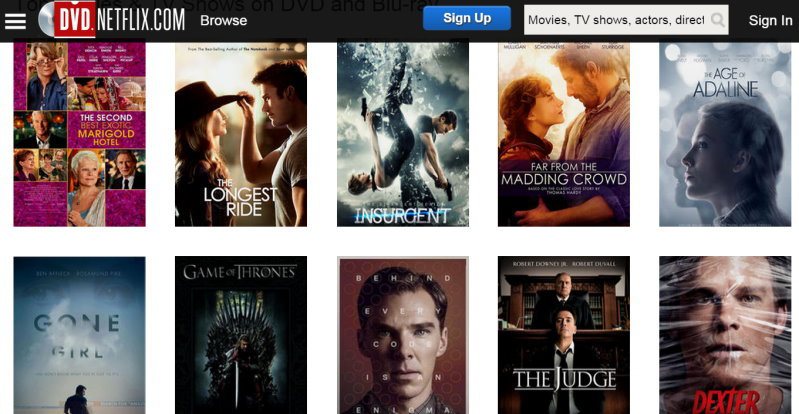It was just past sunrise on morning at Netflix's DVD operations here. Metallic arms whirred in a giant glass box and rolling carts holding millions of DVDs lined the walls of the warehouse. Red envelopes buzzed through an assembly line at the other end.
太陽才剛升起,這裡是Netflix設在美國加州費利蒙市的DVD(數位影音光碟)作業中心。金屬手臂在一個巨型玻璃箱內嗡嗡作響,裝著數百萬片DVD的推車沿著這座倉庫的牆面排列成行,緩緩移動。在倉庫的另一頭,許多紅色信封嗡嗡通過一條裝配線。
The machine sucked a returned Netflix mailer into the system, slice open the envelope, identify and clean the disc inside, check that it worked and reinsert it into the sleeve. That disc was then returned to storage or shipped out to another customer.
這台機器把歸還的Netflix信封吸進系統,割開信封,辨認並清潔裡面的DVD,確認能播放再裝回封套,歸檔存放或運送給另一名顧客。
About 3,400 discs zip through the rental return machine each hour, five times as many as when teams of Netflix employees used to process the discs by hand. Called the Amazing Arm, the machine symbolizes the way Netflix has managed to maintain a profitable physical DVD operation even as it transforms itself into a global streaming service.
平均每個小時有3400片DVD通過這個租片還片機,數量是以前Netflix員工分組以人工處理時的五倍。這台機器名為「了不起的手臂」,象徵著Netflix轉型為全球串流服務商時,還能成功維持實體DVD業務而且繼續賺錢的方法。
Netflix now counts more than 65 million streaming members in more than 50 countries and plans to expand across the world in the next 18 months. But that breakneck growth comes at a cost: The company expects its streaming business to just break even globally through 2016 as it pours billions of dollars into content and an aggressive expansion.
Netflix目前在50多個國家擁有超過6500萬串流會員,並且打算在未來一年半內擴張到全球,不過這樣的急速成長有其必須付出的代價:Netflix預期,由於需要投入數十億美元改善影片內容並積極擴張,就全球而言串流業務要到2016年年底收支才能打平。
Helping fuel that expansion is the company's dwindling, often ignored DVD-by-mail operation, viewed by many as an anachronism in an era of lightning-fast streaming.
促使Netflix擴張的,正是Netflix日漸萎縮、而且常被忽略的DVD郵寄到府業務,許多人認為,在這串流當道的時代,這種業務已經過時了。

Netflix has 5.3 million DVD subscribers, a significant falloff from its peak of about 20 million in 2010; still, the division continues to churn out hundreds of millions of dollars in profit each year. And behind the scenes, engineers are trying to improve customer service and streamline the labor-intensive process of returning, sorting and shipping millions of DVDs each week.
Netflix有530萬DVD訂戶,比2010年高峰時期的2000萬左右少了很多,不過,DVD部門每年仍繼續為公司賺進數億美元利潤,此外,公司的工程師們正努力改善客戶服務,並將每周歸還、整理並運送幾百萬片DVD這勞力密集的流程加以簡化。
The group has kept a core base of customers, particularly in rural zones with lackluster Internet service and among people who want access to the breadth of its selection. To hold on to those customers – and the profits they bring – Netflix continues to deploy innovative technologies that help trim costs and improve customer service.
DVD部門保住了核心客戶,尤其是住在網路服務水準較差的鄉間,以及希望能夠享用Netflix豐富多樣影片的人。為了維繫這些客戶,同時也保住他們帶來的利潤,Netflix不斷採用創新技術已降低成本,並且改進客戶服務。
"Embrace change – that's what I've learned here," said Hank Breeggemann, general manager of Netflix's DVD division.
Netflix的DVD部門總經理漢克.布瑞葛門說:「擁抱改變,這是我在這裡學到的功課。」
If anything, the Netflix story is one of perpetual change. The software executives Reed Hastings and Marc Randolph founded Netflix in 1997 to offer online movie rentals by mail. Netflix introduced streaming in 2007 and plans to be fully global by 2017.
或許不妨這麼說,Netflix的故事告訴我們的是,必須不斷地改變。1997年,軟體公司的高階主管李德.哈斯汀與馬克.蘭多夫創辦了Netflix,提供線上租片並郵寄到府的服務。Netflix2007年開始提供串流影片服務,計畫在2017年前在全球全面提供這種服務。
Netflix's transformation has been rocky at times, but its evolution has become an example of how companies can adapt, tapping their legacy businesses to fuel growth in new areas as the ground underneath them shifts.
Netflix的轉型過程不時也會遭遇困難,不過它的演進已經成為範例,顯示企業如何在獲利基礎轉變時自我調適。利用以往的強項業務,促進新領域的業務成長。
The process required juggling two cultures, one with fast-paced growth and the other in long-term decline, as well as investing in new initiatives, many of which did not work, executives said.
Netflix的高層說,轉型過程必須盡量兼顧兩種工作文化,其中一種業務成長快速,另一種則長期萎縮,此外還須投資於新點子,而其中有許多卻都行不通。
The hurdles are often significant, and few companies make the jump. Only about 10 percent of the companies that appeared on the original Fortune 500 in 1955 remain on the list today.
橫在轉型路上的障礙常常很高,能夠成功越過的公司為數不多。名登1955年財星雜誌500大金榜的企業,僅約10%目前還在榜上。
"That ability to move while the plane is flying from a tailwind to a headwind is challenging, and Reed has done an amazing job of making those changes," said Tim Armstrong, chief executive of AOL, which struggled through a transformation of its own – from a subscription-based Internet service to an ad-supported digital media business. When AOL was sold to Verizon Communications in June, most of its profits still came from its legacy subscription business.
「美國線上」執行長提姆.阿姆斯壯說:「當飛機從順風飛行變成逆風,要讓飛機繼續前進很困難,李德(哈斯汀)在做必要的改變上表現超優。」美國線上也曾在掙扎中轉型,從依靠訂閱的網路服務商轉型成以廣告支撐營運的數位媒體公司。今年六月,美國線上賣給美國電信公司威訊通訊時,多數利潤仍來自以前的強項-訂閱業務。
Four years ago, Mr. Hastings said one of his greatest fears was that the company would not make the leap from DVDs to streaming. Netflix was then suffering from its disastrous attempt to raise prices and split into two companies – one for its DVD mailing group, another for streaming. About a million customers canceled their subscriptions, while Netflix's share price plummeted to less than $53 from $300.
四年前哈斯汀曾說,他最怕的事情之一,就是公司無法從DVD領域跳到串流。當時Netflix試圖提高收費,並打算分拆為兩家公司,一家負責郵寄DVD,另一家負責串流,結果損失慘重,大約一百萬客戶取消訂閱,股價從300美元暴跌到不及53美元。
Within months, Netflix had abandoned the separation. But behind the scenes, it divided the company in two. The streaming side focused on luring subscribers around the globe and producing original series like the political drama "House of Cards," while the DVD division focused on managing the subscriber decline of the mail service by making it more efficient. The two groups have separate management teams, headquarters that are 40 kilometers apart and different employee incentives.
幾個月內,Netflix放棄分拆,但在實際上一分為二:串流部門專門吸引全球各地訂戶,並製作原創影集,例如政治劇「紙牌屋」;DVD部門負責讓郵寄更有效率,以減緩訂戶流失的速度。兩個部門的管理團隊不同,總部相距40公里,員工獎勵方式也不一樣。
Most companies that are great at something, Mr. Hastings said in a 2011 blog post, during the company's tumultuous period, "do not become great at new things people want (streaming for us) because they are afraid to hurt their initial business."
2011年Netflix動盪不安的時候,哈斯汀在部落格發文說,絕大多數擅長做某件事的公司「不會變得擅長做人們想要的新鮮事(對我們而言是串流),因為怕損害到原來的業務」。
He added, "Companies rarely die from moving too fast, and they frequently die from moving too slowly."
他說:「企業絕少因動得太快而死,通常是因為動得太慢才掛掉。」
沒有留言:
張貼留言